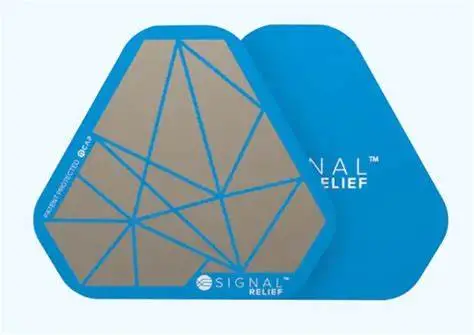Signal Relief Patch is promoted as a reusable, drug-free patch that uses “nano‑capacitor” technology to “turn down” pain signals, claiming to offer fast, chemical-free relief for back, knee, shoulder, and chronic pain. But does this tech work, or is it a placebo wrapped in high-priced marketing?
In this review, I break down what Signal Relief Patch claims, what the formula contains, key warning signs, and whether it can actually help improve pain.
Key Takeaways
- Signal Relief uses unspecified “micro nano-capacitors” to allegedly modulate pain signals, no drugs, no heat, no electricity.
- No peer-reviewed studies, patents, or clinical data back its efficacy, and the company’s claims are vague and unverifiable.
- Customer feedback is mixed: some users report minor relief, others find it ineffective or uncomfortable, and many cite adhesive and cost issues.
- Scientific plausibility is weak: neuromodulation via patches is real (like TENS), but no evidence supports passive nano-patches doing this.
- Alternatives like lidocaine or capsaicin patches have proven mechanisms and are cheaper and regulated.

What Is Signal Relief Patch?
Sold online, Signal Relief Patch is a reusable adhesive patch claimed to contain billions of nano-capacitors that absorb or reroute pain signals. It’s waterproof, reusable for up to a year, and is said to work within minutes when placed correctly on the skin.
How It Claims to Work
- The patch “intercepts” pain signals before they reach the brain using capacitor arrays.
- Placement on or near the pain site is critical, and finding the correct spot may require trial and error.
- It’s marketed as a drug-free, reusable, non-habit-forming alternative to pills or topical gels.
Technology & Efficacy Analysis
- The company offers no patents, explainers, or detail about materials, and there’s no indication of validated continuous electrical activity in the patch.
- Compared to FDA-approved TENS (which actively generate electrical pulses), Signal Relief delivers no electric stimulus, as confirmed by skeptical users and reviewers.
- Claims that the tech originated from Navy SEAL communication research are unsubstantiated and typical of marketing spin.
Red Flags to Consider
No Clinical Evidence or Patents
Despite claims of “clinical trials,” there’s no published data, IRB clearance, or patent filings—just marketing statements .
Mixed Real-World Reports
- Some users (via reliefpatchreviews.com) report mild relief over 36 hours.
- Others found it ineffective, overpriced, adhesive issues, and swelling.
Reddit Skepticism
Many see it as overpriced placebo:
“Placebo shouldn’t have to cost an entire paycheck.”
“Study…32 people total…cooked the study to eliminate people who didn’t claim it works”
Inconsistent Adhesive Quality
Frequent complaints about the patch peeling off or losing stickiness, forcing users to tape it on.
Does It Actually Work?
Possibly for some, but mostly placebo. Some users report mild to moderate relief, often after repositioning the patch over days And others see no effect, find it uncomfortable, or experience worsening pain and residue issues . Without solid data or a credible mechanism, any benefit is anecdotal at best.
Alternatives
If you want proven relief with transparent mechanisms, consider:
- Salonpas patches.
- TENS units.
- Heat or cold gel patches.
- NSAID topical gels.
Conclusion
The Signal Relief Patch is a high-cost, low-evidence “nano-capacitor” gadget that may offer placebo-level pain support for some, but lacks credible science, clinical data, or consistency. Its tech is murky, adhesive problematic, and cost steep. For reliable relief, stick with well-known patches or TENS devices backed by science, not expensive stickers with buzzword claims.
Also Read – I Tried Ark Drops for Energy and Endurance – Here’s Why I Was Disappointed (Review)

Great review, I was considering trying the product but will keep my $ in my pocket. Thank you.